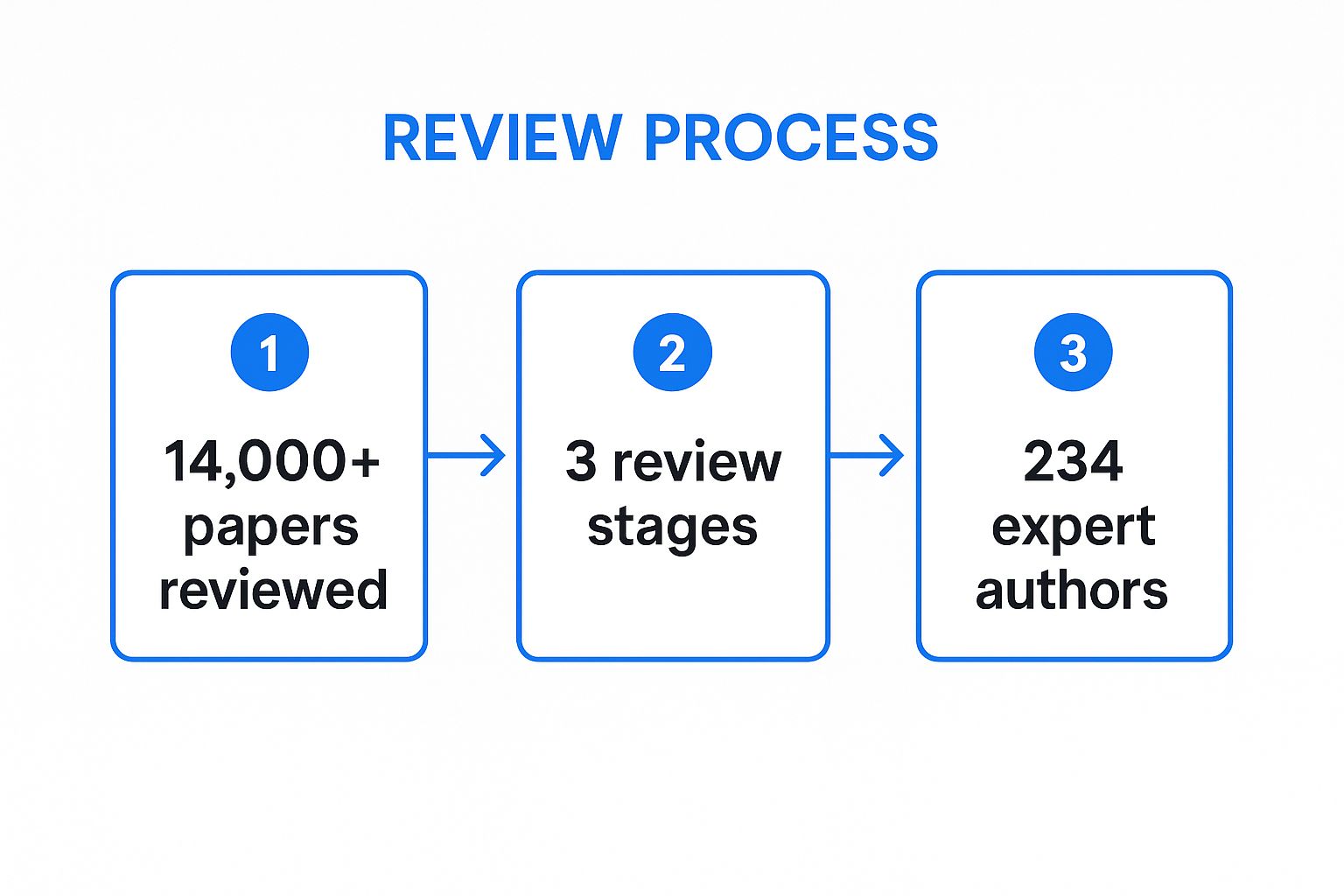Peer-reviewed articles are the gold standard of credible research, but what makes one truly impactful? It's more than just presenting data; it's about impeccable structure, persuasive clarity, and revolutionary ideas that shift an entire field. This article moves beyond surface-level summaries to provide a strategic breakdown of influential research. We offer a curated list featuring a diverse peer reviewed articles example selection, dissecting seven of the most significant papers in modern history, from the discovery of DNA's double helix to the foundational AI model that powers tools like ChatGPT.
For each landmark study, we will analyze its strategic brilliance and highlight the specific methods that transformed a simple publication into a paradigm shift. We extract actionable takeaways and replicable strategies you can apply to your own academic writing and research. Whether you're a student learning to critically read scientific literature, a graduate researcher honing your skills, or a faculty member seeking inspiration, these examples offer a masterclass in effective scholarly communication. Let's explore the anatomy of groundbreaking research and uncover the tactics behind their enduring influence.
1. The Structure of DNA (Watson & Crick, 1953) - Nature
Perhaps the most iconic peer reviewed articles example in modern science, Watson and Crick's 1953 paper in Nature proposed the double helix structure of DNA. Titled "Molecular Structure of Nucleic Acids: A Structure for Deoxyribose Nucleic Acid," this article is a masterclass in presenting a revolutionary concept with profound clarity and conciseness, running just over one page. It fundamentally changed biology by providing a physical model for genetic inheritance and function.
The paper’s success stems from its elegant synthesis of existing chemical data and X-ray diffraction images (notably from Rosalind Franklin and Maurice Wilkins). By integrating these disparate pieces of evidence, the authors were able to propose a simple, yet powerful, model that explained how genetic information could be stored and replicated.

Strategic Breakdown
The article's brilliance lies in its direct and confident tone. Instead of getting lost in technical minutiae, it focuses on the structural features and their immediate biological implications. Its famous closing line, "It has not escaped our notice that the specific pairing we have postulated immediately suggests a possible copying mechanism for the genetic material," hinted at the profound consequences without overstating the claims, a key tactic in high-impact scientific writing.
This approach demonstrates how to frame a discovery not just as a finding, but as a solution to a long-standing scientific puzzle. The structure itself became the answer to the question of heredity.
Actionable Takeaways for Researchers
- Focus on the Core Insight: Distill your complex research into a single, compelling argument. Watson and Crick focused entirely on the structure and its primary implication.
- Leverage Visuals: Their simple diagram of the double helix was crucial. A clear, effective visual can communicate complex ideas more powerfully than dense text.
- Build on Existing Work: Meticulously cite and integrate previous findings to build a stronger, more credible case for your own hypothesis. This positions your work as the next logical step in scientific progress.
- Hint at Future Implications: Conclude by suggesting avenues for future research that your work opens up. This sparks interest and establishes the significance of your findings.
This paper serves as the foundational text for countless modern biological and medical advancements.
2. A Theory of Human Motivation (Maslow, 1943) - Psychological Review
Abraham Maslow’s "A Theory of Human Motivation," published in Psychological Review, is a foundational peer reviewed articles example from the social sciences. This paper introduced the now-famous hierarchy of needs, a theoretical framework that conceptualizes human motivation in ascending stages from basic physiological needs to self-actualization. It transformed psychology by shifting focus from pathology to positive human potential and development.
The article’s enduring impact comes from its powerful synthesis of existing psychological theories and its intuitive, applicable model. Maslow built his argument not on novel experimental data, but on a comprehensive reinterpretation of existing research and clinical observations. He presented a holistic view of human motivation that was both intellectually rigorous and accessible, which allowed it to transcend academia and influence fields from business to education.

Strategic Breakdown
The paper's brilliance lies in its construction of a compelling theoretical argument without relying on new empirical evidence. Maslow strategically reviewed and integrated diverse findings to build a logical case for his hierarchical model. By proposing a clear, tiered structure (physiological, safety, love, esteem, and self-actualization), he created a powerful explanatory tool for understanding complex human behaviors.
This approach demonstrates how to contribute a significant theoretical advancement to a field. The paper argues for a new perspective by connecting disparate observations into a coherent and predictive framework, inviting future empirical validation rather than presenting it as a settled conclusion.
Actionable Takeaways for Researchers
- Propose a Theoretical Framework: A powerful contribution can be a model that synthesizes and organizes existing knowledge, providing a new lens for future research.
- Build on a Comprehensive Literature Review: Ground your theory in a deep and critical analysis of prior work. The strength of Maslow’s argument is built on the foundation of the research he cites, which can be managed effectively by understanding the importance of a reference manager.
- Acknowledge Limitations: Maslow was clear about the theoretical and culturally-bound nature of his hierarchy. Acknowledging limitations and exceptions strengthens your credibility.
- Connect Theory to Application: The hierarchy’s success is partly due to its clear applicability to real-world contexts like management, therapy, and education. Show how your theory can be used.
This article remains a cornerstone in psychology and is a prime example of how a well-structured theoretical paper can shape a discipline.
3. Climate Change 2021: The Physical Science Basis (IPCC Working Group, 2021) - Nature
This landmark report from the Intergovernmental Panel on Climate Change (IPCC) is a monumental peer reviewed articles example that showcases scientific collaboration on an unprecedented scale. Unlike a single-author paper, this synthesis report consolidates the work of hundreds of scientists to provide the most authoritative, comprehensive assessment of climate science. It represents the gold standard for building scientific consensus through a transparent and multi-layered review process.
The report’s power lies in its sheer scope and rigorous methodology. By synthesizing evidence from over 14,000 scientific papers, it establishes an undeniable consensus on the state of the climate system. Its findings directly inform global policy, from international negotiations like the Paris Agreement to national-level climate action plans, serving as the scientific bedrock for critical decision-making worldwide.
The infographic below illustrates the rigorous, multi-stage process used to produce this landmark assessment, highlighting the immense collaborative effort involved.

This process flow visualizes how a massive body of evidence is distilled into a consensus document through multiple layers of expert scrutiny.
Strategic Breakdown
The IPCC's strategy is built on transparency, inclusivity, and authority. By involving hundreds of authors from diverse backgrounds and subjecting drafts to multiple rounds of expert and government review, the process builds unparalleled credibility. The report deliberately separates objective scientific findings from policy recommendations, allowing it to serve as a neutral scientific foundation for policymakers without prescribing specific actions.
This clear demarcation between science and policy is crucial. It ensures the report’s integrity and makes its conclusions difficult to dismiss, transforming complex climate data into an unassailable basis for action. For those managing such large-scale projects, modern approaches to research organization are essential for maintaining coherence and rigor.
Actionable Takeaways for Researchers
- Embrace Collaborative Review: For complex or controversial topics, involve a wide range of experts in a multi-stage review process to strengthen your findings and build consensus.
- Maintain Transparency: Document every stage of your review and synthesis process. A transparent methodology builds trust and enhances the credibility of your conclusions.
- Use Data Visualization for Impact: Condense vast datasets into clear, accessible visuals like graphs and maps. This makes complex information understandable to a broader audience, including policymakers and the public.
- Separate Findings from Advocacy: Clearly distinguish your objective scientific analysis from any policy implications or recommendations. This preserves your scientific neutrality and strengthens your authority.
This report is a masterclass in how to manage and communicate a global scientific consensus.
4. Attention Is All You Need (Vaswani et al., 2017) - NeurIPS Conference Proceedings
This landmark paper from the Google Research team introduced the Transformer architecture, a pivotal moment in artificial intelligence. Presented at the prestigious NeurIPS conference, "Attention Is All You Need" is a prime peer reviewed articles example from computer science, showcasing a blend of theoretical innovation and rigorous experimental validation. It dismantled the reliance on sequential processing (like RNNs) for language tasks, proposing a model based entirely on self-attention mechanisms.
The Transformer's ability to weigh the importance of different words in a sentence simultaneously, regardless of their position, allowed for massive parallelization and a more sophisticated understanding of context. This breakthrough is the direct foundation for modern large language models, including the GPT series (powering ChatGPT) and BERT, as well as advancements in image generation and even protein folding prediction with models like AlphaFold.
Strategic Breakdown
The paper's persuasive power comes from its bold and simple premise: that recurrence and convolutions were not necessary for top-tier language understanding. The authors backed this claim with extensive experiments and ablation studies, systematically proving that each component of their novel architecture was essential. The title itself, "Attention Is All You Need," is a masterstroke of marketing, perfectly encapsulating the core idea in a memorable, confident phrase.
By open-sourcing their code and using standard benchmarks, the authors ensured their revolutionary results were immediately reproducible and verifiable by the wider research community, accelerating adoption and further innovation.
Actionable Takeaways for Researchers
- Make a Bold, Falsifiable Claim: Center your paper around a strong, clear hypothesis. The authors challenged the status quo by claiming attention mechanisms alone were sufficient.
- Validate Each Component: Use ablation studies to justify your design choices. Systematically removing parts of your model to show their impact builds a rock-solid argument.
- Prioritize Reproducibility: Release your code and models. In computational fields, this is the gold standard for credibility and is crucial for building upon your work.
- Benchmark Rigorously: Compare your results against strong, established baselines on standard datasets to clearly demonstrate a state-of-the-art advancement.
This paper fundamentally altered the trajectory of AI research and development.
5. Randomised Trial of Intravenous Streptokinase (ISIS-2, 1988) - The Lancet
The Second International Study of Infarct Survival (ISIS-2), published in The Lancet, is a landmark peer reviewed articles example that set the gold standard for large-scale randomized controlled trials. This massive study involved over 17,000 patients across 16 countries and definitively proved that two inexpensive treatments, streptokinase and aspirin, significantly reduced mortality after a heart attack. Its findings were so clear and impactful that they changed clinical practice almost overnight.
The paper’s power lies in its methodological rigor and sheer scale. By using a "factorial design," the researchers were able to test two separate treatments simultaneously, an efficient and powerful approach. This robust methodology provided irrefutable evidence for simple, accessible interventions, demonstrating how well-designed trials can directly translate into saving countless lives globally.
Strategic Breakdown
The brilliance of ISIS-2 was its pragmatic simplicity and "large, simple trial" design. The entry criteria were straightforward, making it easy for hospitals worldwide to participate, which led to a huge and diverse patient sample. This ensured the results were generalizable and not just applicable to a niche population in a highly specialized research center.
The reporting was equally direct, presenting the mortality data with unambiguous clarity. There was no hiding behind complex statistical jargon; the message was simple: aspirin and streptokinase save lives. This directness made the findings immediately accessible and compelling to clinicians, policymakers, and public health organizations.
Actionable Takeaways for Researchers
- Design for Real-World Impact: Prioritize simplicity and practicality in your trial design to ensure broad applicability and easier recruitment.
- Focus on Clinically Meaningful Outcomes: The primary outcome was "all-cause mortality," a clear and undeniably important metric. Choose endpoints that matter to patients and practitioners.
- Embrace Large-Scale Collaboration: For questions of major public health importance, multi-center international collaborations can provide the statistical power needed for a definitive answer.
- Report with Absolute Clarity: Present your key results in a simple, direct manner. A clear graph showing a major reduction in death is more powerful than a table filled with p-values.
This paper became a template for subsequent large cardiovascular trials and informed emergency medicine protocols worldwide.
6. The Global Burden of Disease Study 2019 (GBD Collaborators, 2020) - The Lancet
The Global Burden of Disease (GBD) study represents a monumental peer reviewed articles example of collaborative, large-scale epidemiological research. Published annually in The Lancet, this work is the most comprehensive and systematic effort to quantify health loss across the globe from hundreds of diseases, injuries, and risk factors. It provides a standardized framework for comparing the health of populations over time and across geographies.
The study’s power lies in its massive data synthesis, drawing from thousands of sources to produce consistent and comparable estimates. This unparalleled scope and rigorous methodology make it an authoritative resource for global health policy, guiding decisions by organizations like the World Health Organization and the World Bank. The GBD project exemplifies how to manage and present immense datasets to produce actionable public health intelligence.
Strategic Breakdown
The GBD’s strategic genius is its commitment to methodological transparency and systematic, regular updates. By openly documenting all assumptions, data sources, and statistical models, the collaborators build immense credibility and allow for robust scientific scrutiny. The annual publication cycle ensures the data remains current and relevant, transforming the study from a static report into a dynamic, evolving public health tool.
This approach establishes the GBD not just as a research paper but as an indispensable piece of global infrastructure. It standardizes metrics like Disability-Adjusted Life Years (DALYs), creating a common language for policymakers to discuss and prioritize health challenges.
Actionable Takeaways for Researchers
- Embrace Radical Transparency: Clearly document all methodological assumptions, data inputs, and statistical processes. This builds trust and allows other researchers to replicate and build upon your work.
- Standardize Your Metrics: Develop and use consistent metrics for comparison. This makes your findings more impactful and useful for comparative analysis and policy-making.
- Make Data Accessible: Provide public access to your findings, ideally through interactive visualization tools. This dramatically increases the reach and utility of your research beyond academia.
- Foster Global Collaboration: Engage a diverse, international network of collaborators. This improves data quality, ensures local relevance, and enhances the global legitimacy of the findings.
The GBD study provides a blueprint for conducting research that directly informs and shapes global policy and health investments.
7. CRISPR-Cas9 Genome Editing (Jinek et al., 2012) - Science
A monumental peer reviewed articles example that sparked a biotech revolution, Jinek and colleagues' 2012 paper in Science demonstrated how the bacterial CRISPR-Cas9 system could be harnessed as a programmable genome-editing tool. Titled "A Programmable Dual-RNA-Guided DNA Endonuclease in Adaptive Bacterial Immunity," this article detailed the mechanism for precisely cutting DNA at a specific target, laying the groundwork for a new era in genetic engineering. It transformed a component of a bacterial immune system into one of the most powerful and accessible technologies in molecular biology.
The paper meticulously detailed how the Cas9 protein, guided by a synthetic single-guide RNA (sgRNA), could be directed to cut any desired DNA sequence. This fundamental insight simplified a complex natural system, making it a versatile tool for researchers worldwide to edit genes in a wide range of organisms, from bacteria to humans. This work was a key contribution that led to the 2020 Nobel Prize in Chemistry for Emmanuelle Charpentier and Jennifer Doudna.

Strategic Breakdown
The article’s power comes from its clear presentation of a complex biochemical mechanism alongside its elegant simplification for practical use. The authors didn't just discover how the system worked; they engineered a streamlined version, proving its potential as a general-purpose technology. This shift from description to application is what made the paper so influential.
By demonstrating the system's programmability with multiple examples, the authors effectively provided a blueprint for other scientists. They established not just a finding but a platform, inviting the entire scientific community to build upon their work and explore its vast possibilities, which now include therapies for sickle cell disease and advanced agricultural applications.
Actionable Takeaways for Researchers
Combine Mechanism with Application: Don't just explain how something works. Demonstrate how it can be used*. This article bridged fundamental biochemistry with a transformative technological application.- Provide Clear, Reproducible Protocols: The paper's methods were detailed enough for other labs to replicate and adapt the technology immediately, accelerating its adoption. Clear methodology is the cornerstone of impactful science.
- Simplify for Accessibility: The authors’ key innovation was simplifying the natural dual-RNA system into a single-guide RNA. Making your discovery easier for others to use can dramatically increase its impact.
- Use Visuals to Clarify Mechanisms: The paper employed clear diagrams to illustrate the molecular interactions of Cas9, guide RNA, and target DNA. Effective visuals are essential for explaining complex biological processes. Keeping detailed notes with a top-tier reference manager for annotations can help organize these complex visual and textual data points during research.
Key Attributes of 7 Peer-Reviewed Article Examples
| Paper / Report Title | Implementation Complexity 🔄 | Resource Requirements ⚡ | Expected Outcomes 📊 | Ideal Use Cases 💡 | Key Advantages ⭐ |
|---|---|---|---|---|---|
| The Structure of DNA (Watson & Crick, 1953) | Moderate: concise, hypothesis-driven with modeling | Low: brief data, based on existing research and X-ray data | Revolutionary insight into DNA structure; immediate genetics impact | Molecular biology, genetics research | Clear visual model, concise, high impact, strong theory |
| A Theory of Human Motivation (Maslow, 1943) | Low: theoretical framework, qualitative approach | Low: literature review and philosophical reasoning | Framework for understanding motivation across contexts | Psychology, education, management, therapy | Highly accessible, adaptable, practical cross-field use |
| Climate Change 2021 (IPCC, 2021) | Very high: multi-stage review, large collaboration | Very high: 234 authors, 14,000+ studies analyzed | Authoritative, consensus-based climate science synthesis | Policy making, international climate negotiations | Highest credibility, global collaboration, transparent process |
| Attention Is All You Need (Vaswani et al., 2017) | High: novel neural architecture, mathematical rigor | High: requires large data and computational resources | Breakthrough AI model enabling faster, accurate NLP | AI research, language models, advanced machine learning | Eliminates RNN limits, fast training, reproducible, impactful |
| Randomised Trial of Intravenous Streptokinase (ISIS-2, 1988) | High: large RCT, complex trial design | Very high: 17,187 patients, multi-center international study | Definitive clinical evidence changing treatment standards | Clinical medicine, cardiology, emergency protocols | Rigorous design, statistically powerful, global impact |
| Global Burden of Disease Study 2019 (GBD, 2020) | Very high: systematic analysis across many countries | Very high: 5,000+ collaborators, extensive data processing | Comprehensive public health priorities & policy guidance | Epidemiology, global health policy, resource allocation | Open data, standardized metrics, broad coverage, transparency |
| CRISPR-Cas9 Genome Editing (Jinek et al., 2012) | High: mechanistic biochemistry and experimental work | Moderate to high: lab experiments and molecular studies | Precise genome editing technology with broad biotechnological impacts | Genetic engineering, medical therapies, biotech innovation | Simple, precise, cost-effective, detailed methods, Nobel-winning |
From Paper to Practice: Applying These Lessons to Your Research
The seven diverse articles we've explored, from Watson and Crick's concise paradigm shift to the IPCC's massive collaborative synthesis, share fundamental DNA. Each peer reviewed articles example demonstrates that groundbreaking research is not just about a brilliant idea; it’s about the meticulous execution, strategic communication, and clear articulation of that idea. They prove that impact is born from a potent combination of rigorous methodology and a compelling narrative that resonates within and beyond a specific field.
Whether it’s the clear, falsifiable hypothesis in the ISIS-2 trial or the elegant conceptual framework of Maslow's hierarchy, these papers offer more than just findings. They provide a strategic blueprint for structuring your own arguments, designing your methods, and presenting your data in a way that commands attention and withstands scrutiny. They show us how to build upon existing knowledge while simultaneously forging new paths.
Distilling the Core Strategies for Your Work
To translate these lessons into your own research endeavors, focus on the replicable tactics demonstrated by these landmark studies. These are not abstract ideals but practical, actionable principles you can implement today.
- Clarity Over Complexity: The most profound ideas are often the most clearly expressed. Watson and Crick's paper is a masterclass in this, using under 1000 words to change biology forever. Prioritize concise language and a logical structure that guides your reader effortlessly from your research question to your conclusion.
- Methodological Transparency: Your results are only as strong as your methods. The GBD 2019 study and the ISIS-2 trial showcase the power of transparent, robust, and well-documented methodologies. This builds trust and provides a solid foundation for others to replicate and build upon your work.
- Narrative and Framing: Every great paper tells a story. Vaswani et al. didn't just present a new architecture; they framed it as a solution to a fundamental limitation in existing models ("Attention Is All You Need"). Frame your research within a broader context to highlight its significance and necessity.
Your Next Steps: From Inspiration to Publication
Moving forward, the goal is to internalize these strategic approaches. As you conduct your literature reviews and begin drafting your manuscripts, continually ask yourself how the principles from each peer reviewed articles example can be applied. Think about how the CRISPR-Cas9 paper built a compelling case for a new technology or how the IPCC report synthesized vast amounts of data into a coherent, impactful message.
The journey from initial concept to a published, peer-reviewed article is a marathon. It requires not only intellectual rigor but also exceptional organization. The ability to manage, search, and synthesize insights from dozens or even hundreds of sources is a critical skill. By adopting the strategic principles from these landmark papers and leveraging smart tools to organize your knowledge base, you can streamline your workflow and accelerate your progress from literature review to discovery. The next groundbreaking paper is waiting to be written.
Ready to turn your library of research into actionable insights? Stop wrestling with disorganized PDFs and discover a smarter way to work with your sources. Eagle Cite allows you to upload, search, and chat with your academic papers using natural language, helping you find the exact information you need in seconds. Get started with Eagle Cite and supercharge your research today.